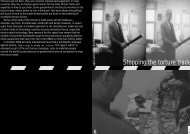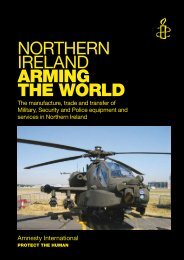CROWD CONTROL TECHNOLOGIES - Omega Research Foundation
CROWD CONTROL TECHNOLOGIES - Omega Research Foundation
CROWD CONTROL TECHNOLOGIES - Omega Research Foundation
You also want an ePaper? Increase the reach of your titles
YUMPU automatically turns print PDFs into web optimized ePapers that Google loves.
Most of these crowd control weapons have also been configured into vehicle or aircraft launched<br />
formats, some of which are served by a crew acting as a mobile riot dispersal unit. Examples include<br />
water cannon, armoured personnel carriers & internal security vehicles with CS dispensers, plastic<br />
baton guns, helicopters equipped with CS sprayers, electrified riot control vehicles and mobile razor<br />
wire dispensing vehicles. Many of these non lethal weapon platforms also carry lethal weapons and<br />
munitions.<br />
This increasing availability means that many more countries are now willing to actually use these<br />
technologies. A key finding of this study is that at least 110 countries worldwide have deployed crowd<br />
control weapons including chemical irritants, kinetic weapons and water cannon. (See Appendix 7).<br />
This figure is an underestimate because not all countries report on their crowd control arsenals. Of<br />
these 110 countries, it was found that 44 also manufacture, supply or distribute such crowd control<br />
weapons and ammunition. One of the most salient findings of this study concerns the alleged<br />
effectiveness of these weapons as an humane substitute for lethal force. The present study found<br />
many examples in 47 countries, of these so called non-lethal alternatives being used in conjunction<br />
with lethal force, in many cases leading directly to injury and fatalities.(See Appendix 6). Again this<br />
assessment probably underestimates the level of augmentation of lethal and non lethal weapons<br />
deployment. The survey conducted via Amnesty International for this study found that some States<br />
themselves are ignorant about the crowd control weapon holdings of their Military, Security, Police<br />
forces. (See Appendix 2) The commitments made in the Amsterdam Treaty cannot possibly be fulfilled<br />
whilst governments are ignorant of there own instruments and capabilities for crowd control. All<br />
European governments should be in a position to report on their crowd control weapon holdings as a<br />
matter of policy and this data should be readily available as public documents. For example, it was of<br />
concern that the German Embassy responded that )according to the German Authorities, the<br />
detailed information in the form requested is not held centrally and could only be obtained at<br />
disproportionate cost(. This inability to supply data on chemical irritant holdings would appear<br />
puzzling, given the German governments obligation to provide such data to the Chemical Weapons<br />
Convention Inspectorate in the Hague, as stipulated by the CWC Treaty.<br />
In the mid 1990's, the range of available non lethal weapon technologies rapidly changed in the<br />
wake of the US non-lethal weapons doctrine and procurement program discussed in Section 6 below.<br />
These include some of the variants already mentioned such as crowd control agents, kinetic energy<br />
weapons and others which are coming into use such as capture nets and entanglements as well as a<br />
range of what are colloquially known as stick-ums and slick-ums. NATO has quite recently adopted<br />
(on 27 th September 1999) a new )NATO policy on non-lethal weapons( which cover a range of options<br />
for military commanders especially for the purposes of peace-keeping and peace-enforcement. A key<br />
motivation behind this policy statement is thought to be a political one i.e. removing the political and<br />
legal obstacles to deploying these technologies, which is further discussed in Section 6 below.<br />
Nevertheless, despite this substantial proliferation, until fairly recently the forms of technology<br />
commonly available were almost identical to the 34 categories of crowd control weapons identified in<br />
the 1972 US National Science <strong>Foundation</strong> report on )Non-Lethal Weapons(. 27 At the end of the 1990's,<br />
outside of the USA, this typology of crowd control weapons continues to consist largely of systems<br />
based on chemical irritant; kinetic energy; water jets; thunder flashes (stun-grenades); and electroshock<br />
devices. What has changed is the relative power, sophistication and the combination of different<br />
operational effects within single weapon systems to achieve enhanced dispersion, capture, control or<br />
punishment.<br />
Overall performance characteristics of all crowd control weapons generally fall into two categories<br />
namely:- (i) those that determine the effect on the target if the target is hit (muzzle velocity, projectile<br />
weight and drag), and (ii) those that determine if the target is hit (accuracy and reliability).The relative<br />
importance of these two categories will vary from weapon to weapon. For example, with chemical<br />
devices even though the performance characteristics fall into the same two categories, the distinction<br />
between a )hit( and a )no-hit( is not required to be so precise as compared with kinetic energy<br />
xx




